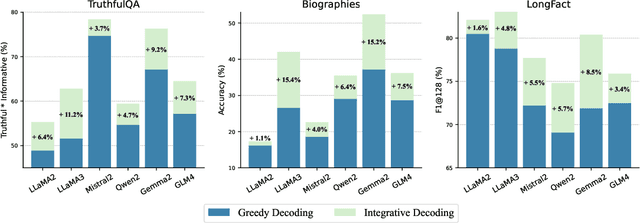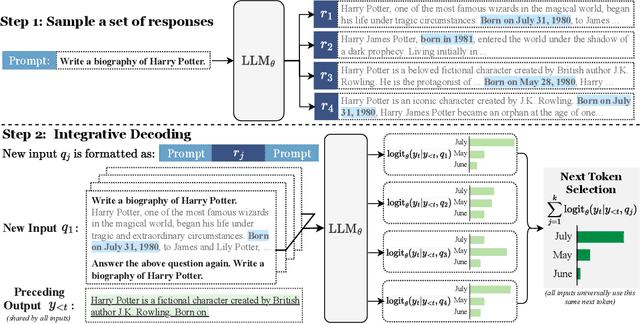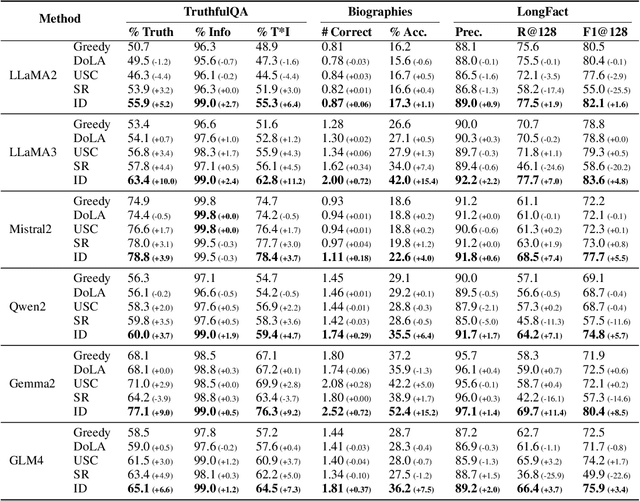Jian Jiao
Training Matryoshka Mixture-of-Experts for Elastic Inference-Time Expert Utilization
Sep 30, 2025Abstract:Mixture-of-Experts (MoE) has emerged as a promising paradigm for efficiently scaling large language models without a proportional increase in computational cost. However, the standard training strategy of Top-K router prevents MoE models from realizing their full potential for elastic inference. When the number of activated experts is altered at inference time, these models exhibit precipitous performance degradation. In this work, we introduce Matryoshka MoE (M-MoE), a training framework that instills a coarse-to-fine structure directly into the expert ensemble. By systematically varying the number of activated experts during training, M-MoE compels the model to learn a meaningful ranking: top-ranked experts collaborate to provide essential, coarse-grained capabilities, while subsequent experts add progressively finer-grained detail. We explore this principle at multiple granularities, identifying a layer-wise randomization strategy as the most effective. Our experiments demonstrate that a single M-MoE model achieves remarkable elasticity, with its performance at various expert counts closely matching that of an entire suite of specialist models, but at only a fraction of the total training cost. This flexibility not only unlocks elastic inference but also enables optimizing performance by allocating different computational budgets to different model layers. Our work paves the way for more practical and adaptable deployments of large-scale MoE models.
GLM-4.5: Agentic, Reasoning, and Coding (ARC) Foundation Models
Aug 08, 2025Abstract:We present GLM-4.5, an open-source Mixture-of-Experts (MoE) large language model with 355B total parameters and 32B activated parameters, featuring a hybrid reasoning method that supports both thinking and direct response modes. Through multi-stage training on 23T tokens and comprehensive post-training with expert model iteration and reinforcement learning, GLM-4.5 achieves strong performance across agentic, reasoning, and coding (ARC) tasks, scoring 70.1% on TAU-Bench, 91.0% on AIME 24, and 64.2% on SWE-bench Verified. With much fewer parameters than several competitors, GLM-4.5 ranks 3rd overall among all evaluated models and 2nd on agentic benchmarks. We release both GLM-4.5 (355B parameters) and a compact version, GLM-4.5-Air (106B parameters), to advance research in reasoning and agentic AI systems. Code, models, and more information are available at https://github.com/zai-org/GLM-4.5.
ColBERT-serve: Efficient Multi-Stage Memory-Mapped Scoring
Apr 21, 2025Abstract:We study serving retrieval models, specifically late interaction models like ColBERT, to many concurrent users at once and under a small budget, in which the index may not fit in memory. We present ColBERT-serve, a novel serving system that applies a memory-mapping strategy to the ColBERT index, reducing RAM usage by 90% and permitting its deployment on cheap servers, and incorporates a multi-stage architecture with hybrid scoring, reducing ColBERT's query latency and supporting many concurrent queries in parallel.
DeepThink: Aligning Language Models with Domain-Specific User Intents
Feb 08, 2025Abstract:Supervised fine-tuning with synthesized instructions has been a common practice for adapting LLMs to domain-specific QA tasks. However, the synthesized instructions deviate from real user questions and expected answers. This study proposes a novel framework called DeepThink to generate high-quality instructions. DeepThink first generates a few seed questions to mimic actual user questions, simulates conversations to uncover the hidden user needs, and refines the answer by conversational contexts and the retrieved documents for more comprehensive answers. Experiments demonstrate that DeepThink achieves an average performance improvement of 7.92% compared to a GPT-4-turbo+RAG-based assistant on the real user test set in the advertising domain across dimensions such as relevance, completeness, clarity, accuracy, and actionability.
Sigma: Differential Rescaling of Query, Key and Value for Efficient Language Models
Jan 23, 2025



Abstract:We introduce Sigma, an efficient large language model specialized for the system domain, empowered by a novel architecture including DiffQKV attention, and pre-trained on our meticulously collected system domain data. DiffQKV attention significantly enhances the inference efficiency of Sigma by optimizing the Query (Q), Key (K), and Value (V) components in the attention mechanism differentially, based on their varying impacts on the model performance and efficiency indicators. Specifically, we (1) conduct extensive experiments that demonstrate the model's varying sensitivity to the compression of K and V components, leading to the development of differentially compressed KV, and (2) propose augmented Q to expand the Q head dimension, which enhances the model's representation capacity with minimal impacts on the inference speed. Rigorous theoretical and empirical analyses reveal that DiffQKV attention significantly enhances efficiency, achieving up to a 33.36% improvement in inference speed over the conventional grouped-query attention (GQA) in long-context scenarios. We pre-train Sigma on 6T tokens from various sources, including 19.5B system domain data that we carefully collect and 1T tokens of synthesized and rewritten data. In general domains, Sigma achieves comparable performance to other state-of-arts models. In the system domain, we introduce the first comprehensive benchmark AIMicius, where Sigma demonstrates remarkable performance across all tasks, significantly outperforming GPT-4 with an absolute improvement up to 52.5%.
Distributed satellite information networks: Architecture, enabling technologies, and trends
Dec 17, 2024



Abstract:Driven by the vision of ubiquitous connectivity and wireless intelligence, the evolution of ultra-dense constellation-based satellite-integrated Internet is underway, now taking preliminary shape. Nevertheless, the entrenched institutional silos and limited, nonrenewable heterogeneous network resources leave current satellite systems struggling to accommodate the escalating demands of next-generation intelligent applications. In this context, the distributed satellite information networks (DSIN), exemplified by the cohesive clustered satellites system, have emerged as an innovative architecture, bridging information gaps across diverse satellite systems, such as communication, navigation, and remote sensing, and establishing a unified, open information network paradigm to support resilient space information services. This survey first provides a profound discussion about innovative network architectures of DSIN, encompassing distributed regenerative satellite network architecture, distributed satellite computing network architecture, and reconfigurable satellite formation flying, to enable flexible and scalable communication, computing and control. The DSIN faces challenges from network heterogeneity, unpredictable channel dynamics, sparse resources, and decentralized collaboration frameworks. To address these issues, a series of enabling technologies is identified, including channel modeling and estimation, cloud-native distributed MIMO cooperation, grant-free massive access, network routing, and the proper combination of all these diversity techniques. Furthermore, to heighten the overall resource efficiency, the cross-layer optimization techniques are further developed to meet upper-layer deterministic, adaptive and secure information services requirements. In addition, emerging research directions and new opportunities are highlighted on the way to achieving the DSIN vision.
Integrative Decoding: Improve Factuality via Implicit Self-consistency
Oct 02, 2024



Abstract:Self-consistency-based approaches, which involve repeatedly sampling multiple outputs and selecting the most consistent one as the final response, prove to be remarkably effective in improving the factual accuracy of large language models. Nonetheless, existing methods usually have strict constraints on the task format, largely limiting their applicability. In this paper, we present Integrative Decoding (ID), to unlock the potential of self-consistency in open-ended generation tasks. ID operates by constructing a set of inputs, each prepended with a previously sampled response, and then processes them concurrently, with the next token being selected by aggregating of all their corresponding predictions at each decoding step. In essence, this simple approach implicitly incorporates self-consistency in the decoding objective. Extensive evaluation shows that ID consistently enhances factuality over a wide range of language models, with substantial improvements on the TruthfulQA (+11.2%), Biographies (+15.4%) and LongFact (+8.5%) benchmarks. The performance gains amplify progressively as the number of sampled responses increases, indicating the potential of ID to scale up with repeated sampling.
CROSS-JEM: Accurate and Efficient Cross-encoders for Short-text Ranking Tasks
Sep 15, 2024Abstract:Ranking a set of items based on their relevance to a given query is a core problem in search and recommendation. Transformer-based ranking models are the state-of-the-art approaches for such tasks, but they score each query-item independently, ignoring the joint context of other relevant items. This leads to sub-optimal ranking accuracy and high computational costs. In response, we propose Cross-encoders with Joint Efficient Modeling (CROSS-JEM), a novel ranking approach that enables transformer-based models to jointly score multiple items for a query, maximizing parameter utilization. CROSS-JEM leverages (a) redundancies and token overlaps to jointly score multiple items, that are typically short-text phrases arising in search and recommendations, and (b) a novel training objective that models ranking probabilities. CROSS-JEM achieves state-of-the-art accuracy and over 4x lower ranking latency over standard cross-encoders. Our contributions are threefold: (i) we highlight the gap between the ranking application's need for scoring thousands of items per query and the limited capabilities of current cross-encoders; (ii) we introduce CROSS-JEM for joint efficient scoring of multiple items per query; and (iii) we demonstrate state-of-the-art accuracy on standard public datasets and a proprietary dataset. CROSS-JEM opens up new directions for designing tailored early-attention-based ranking models that incorporate strict production constraints such as item multiplicity and latency.
On the Necessity of World Knowledge for Mitigating Missing Labels in Extreme Classification
Aug 18, 2024Abstract:Extreme Classification (XC) aims to map a query to the most relevant documents from a very large document set. XC algorithms used in real-world applications learn this mapping from datasets curated from implicit feedback, such as user clicks. However, these datasets inevitably suffer from missing labels. In this work, we observe that systematic missing labels lead to missing knowledge, which is critical for accurately modelling relevance between queries and documents. We formally show that this absence of knowledge cannot be recovered using existing methods such as propensity weighting and data imputation strategies that solely rely on the training dataset. While LLMs provide an attractive solution to augment the missing knowledge, leveraging them in applications with low latency requirements and large document sets is challenging. To incorporate missing knowledge at scale, we propose SKIM (Scalable Knowledge Infusion for Missing Labels), an algorithm that leverages a combination of small LM and abundant unstructured meta-data to effectively mitigate the missing label problem. We show the efficacy of our method on large-scale public datasets through exhaustive unbiased evaluation ranging from human annotations to simulations inspired from industrial settings. SKIM outperforms existing methods on Recall@100 by more than 10 absolute points. Additionally, SKIM scales to proprietary query-ad retrieval datasets containing 10 million documents, outperforming contemporary methods by 12% in offline evaluation and increased ad click-yield by 1.23% in an online A/B test conducted on a popular search engine. We release our code, prompts, trained XC models and finetuned SLMs at: https://github.com/bicycleman15/skim
Task Oriented In-Domain Data Augmentation
Jun 24, 2024



Abstract:Large Language Models (LLMs) have shown superior performance in various applications and fields. To achieve better performance on specialized domains such as law and advertisement, LLMs are often continue pre-trained on in-domain data. However, existing approaches suffer from two major issues. First, in-domain data are scarce compared with general domain-agnostic data. Second, data used for continual pre-training are not task-aware, such that they may not be helpful to downstream applications. We propose TRAIT, a task-oriented in-domain data augmentation framework. Our framework is divided into two parts: in-domain data selection and task-oriented synthetic passage generation. The data selection strategy identifies and selects a large amount of in-domain data from general corpora, and thus significantly enriches domain knowledge in the continual pre-training data. The synthetic passages contain guidance on how to use domain knowledge to answer questions about downstream tasks. By training on such passages, the model aligns with the need of downstream applications. We adapt LLMs to two domains: advertisement and math. On average, TRAIT improves LLM performance by 8% in the advertisement domain and 7.5% in the math domain.
 Add to Chrome
Add to Chrome Add to Firefox
Add to Firefox Add to Edge
Add to Edge